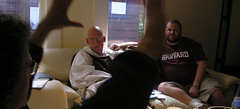Psychogeography of the Border: A Short History
 In 1700, it was possible to travel across the borders of states without knowing that one had crossed from one region into the next. In 2000, a traveler stopped and searched by customs could hardly avoid the knowledge of nations. Yet the same traveler in Chicago or New York might daily drive past neighborhoods of which he had no knowledge, passing through the invisible boundaries of spaces he had no ability to read.
In 1700, it was possible to travel across the borders of states without knowing that one had crossed from one region into the next. In 2000, a traveler stopped and searched by customs could hardly avoid the knowledge of nations. Yet the same traveler in Chicago or New York might daily drive past neighborhoods of which he had no knowledge, passing through the invisible boundaries of spaces he had no ability to read. The dawn of the modern era saw a boom in technologies of navigation, the result of concerted travel from the Grand Tour to continental exploration to travel for the fiscal-military state. Broadly construed, those tools included not merely the cartographic rules for longitude and latitude, but the whole category of the social tools the traveler uses to tell where he is: drawing, hand signs, and printed guidebooks offered techniques for navigating around cultural boundaries, social difference, and government presence.
Equally significant to the tools themselves, however, was the radical hopes for transparency that spatial tools engendered. The cosmopolitan subject was imagined as a traveler, a freemason, for example, whose social connections enabled him to drift from port to port, exchanging information and trading freely no matter where he landed.
The dream of transparent geography began to break down almost as soon as it was launched. The same technologies of navigation created new, invisible frontiers. Watching the masses of tourists and soldiers travel, blinded by disregard for the interior boundaries they crossed, critical travelers described the geographies they themselves saw: islands of routine, colonies of clerks, savannas of mass culture, lakes of ethnic enclaves, each fixed in space, separated from other subgroups by an invisible boundary, across which members of those territories could not see, into which outsiders rarely peeped. The results are well known to urban historians: gentlemen slumming London's ghettos for sex in the 1820s; Dana's Ten Years Before the Mast; and middle-class reformers entering the slums full of ideas. As soon as modern subjects encountered the invisible frontier, they tried to tame it.
What they discovered was an unknown geography in a state of constant flux that defied the now conventional means of navigation. Those places so marked by their invisible boundaries were in fact generated by many of the same modern processes that had shaped so much navigation: new frontiers in circulation, migration, building, representation, affiliation, and the institutionalization of knowledge.
(sketch of a short article in progress)
(thanks, bill rankin, for the atlases!!)










1 Comments:
good article, i hope you finish it soon
Post a Comment
<< Home